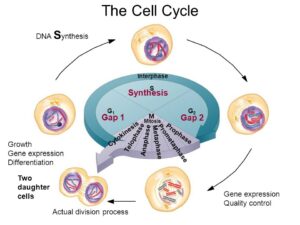Is Dna Synthesized Continuously During the Cell Cycle Between Cell Division How Long is the Phrase
The cell cycle consists of two major phases which are interphase and the mitotic phase. During interphase, the cell grows & DNA is replicated. Interphase is followed by the mitotic phase. the duplicated chromosomes are segregated and distributed into daughter nuclei during the mitotic phase. the replicated DNA & cytoplasmic contents are separated and the cell divides.
The cell cycle
The cell cycle is the alternation between interphase and mitosis that occurs through a regulated sequence of events to control cell growth, function, and division. Most cells undergo repeated cell cycles, each is divided into 2 major events:
- Interphase: a relatively-longer period, during which the cell increases in size, performs all its normal functions, and replicates its genetic material for preparing itself for the division.
- Mitosis: a shorter period during which parent cell gives 2 daughter cells each containing the same number of chromosomes identical to that of the parent cell (46 chromosomes in human).
Interphase
This is the stage between two successive cell divisions. All human somatic cells in the interphase have 46 chromosomes (22 pairs of autosomes + 1 pair of sex chromosomes). Each pair is formed of two homologous chromosomes one coming from the father and the other from the mother.
Thus, the somatic cell contains the diploid number of chromosomes (2n) while each germ cell contains the haploid number 23 chromosomes (1n). The fusion of a sperm and an ovum results in a cell with the diploid number. Interphase is subdivided into three phases, G1, S, and G2.

Cell cycle
First gap phase (G1 phase)
- This is the longest period of the cell cycle between the end of mitosis and the beginning of DNA replication.
- G1 is a phase of cell growth during which the RNA and protein synthesis occurs.
- The cell attains its full size (i.e. previous size before mitosis) and performs its function.
- Duplication of the centrioles occurs near the transition between the G1 and S phase.
The Go phase
Most cells of multicellular organisms differentiate to carry out specialized functions and no longer divide. Such cells are considered to be outside the cycle in the Go phase which is not necessarily permanent. Go cells may reenter the cell cycle in response to a variety of stimuli.
DNA synthesis phase (S phase)
- Replication of DNA takes place so that the DNA content of the nucleus becomes duplicated.
- The amount of DNA is doubled but the total chromosomal number remains 46.
Accordingly, there are two forms of chromosomes present in a cell along with its cell cycle:
- S-chromosomes, each chromosome is made of one DNA molecule (interphase chromosomes = chromatin threads or chromatids).
- d-chromosomes (mitotic chromosomes) which are formed during the S phase. Each d-chromosome is formed of two sister chromatids, linked to each other at the centromere. Each chromatid is made of a DNA molecule.
Second gap phase (G2 phase)
- This is a relatively brief period that starts by the end of the DNA replication and lasts until the beginning of mitosis.
- During this phase, proteins and energy essential to mitosis are stored.
- Duplication of the centrosome is completed i.e. formed of two pairs of centrioles.
Regulation of the cell cycle
The cell cycle is regulated by a series of growth factors that control cell proliferation to keep its coordination with the needs of the living organism. Throughout the cycle, several internal quality control mechanisms or checkpoints control the transition between the cycle stages. Checkpoints control the transition between the cycle stages. Checkpoints detect external or internal problems and stop the cycle until the suitable conditions are fulfilled.
There are five major types of checkpoints
The restriction checkpoint is the most important checkpoint in the cell cycle. It occurs in the G1 phase and is sensitive to the size of the cell and to its interactions with the surrounding extracellular matrix. Cells that do not receive appropriate growth stimuli from their environment do not progress past this point (G1 phase) and will be eliminated by apoptosis.
DNA damage checkpoints occur in G1, S, and G2 phases of the cell cycle. These checkpoints block cell cycle progression until the repair of the damaged DNA or cell apoptosis occurs.
The unreplicated DNA checkpoint in the G2 phase. This prevents the progression of the cycle into the M phase before the complete synthesis of DNA.
The spindle assembly checkpoint (the metaphase checkpoint) occurs in mitosis. It prevents premature entry into anaphase until all chromosomes have attached properly to the mitotic spindle.
The chromosome-segregation checkpoint prevents the process of cytokinesis until all of the chromosomes have been correctly separated.
Cytoplasmic organelles, Ribosomes & Endoplasmic reticulum function, structure & definition
Cell Structure, the function of Golgi apparatus, Endosomes & Lysosomes
The function of Cytoplasmic organelles, Mitochondria, Peroxisomes & Cytoskeleton
Structure of Cytoplasm, The function of centrosome & Cytoplasmic inclusions
Nucleus components, function, diagram & classification of chromosomes
Cell division types, Mitosis, Meiosis, Reductional division & Equatorial division
Source: https://www.online-sciences.com/biology/regulation-of-the-cell-cycle-dna-synthesis-phase-interphase-mitosis/
0 Response to "Is Dna Synthesized Continuously During the Cell Cycle Between Cell Division How Long is the Phrase"
Post a Comment